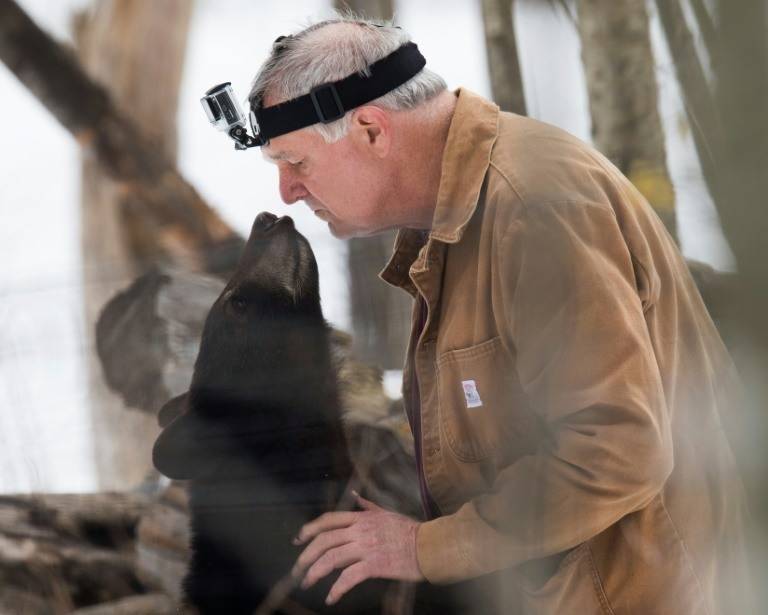Stripy and Jake are bear cubs fed by bottle, who frisk around happily. Other bear orphans perch in the trees when Ben Kilham ventures into their enclosure.
Meet the American bear whisperer, who lives in the woods of New Hampshire and whose life work is understanding black bears, winning him not just international stature but greater insight into humankind.
From the bear photos and paintings on the wall, to the three little wooden bears bidding visitors "welcome" at the entrance, everything in his renovated barn home exudes his passion.
So does the nearby, three-hectare (7.5-acre) enclosure, where he cares for orphan cubs entrusted to him each year by the New Hampshire fish and game department.
With their mothers perhaps shot dead or knocked down by a car, the six-foot-four (1.93 meter) Kilham makes sure they grow up safe and well, before releasing them back into the wild aged 18 months.
In addition he observes adult bears in the wild, including Squirty, who is now 22 years old and has had 11 litters.
His dedication to black bears -- the most common in North America with a population of around 750,000 -- has made him such an expert that China asked for his help with the giant panda, a collaboration that inspired the recently released documentary "Pandas."
After a quarter of a century of study, Kilham has no doubt that bears are as close to humans as great apes, even if as he says, apes "were our closest genetic relative."
He quickly realized that female bears were capable, like humans, of "reciprocal altruism" -- or in other words looking after each other for the greater good.
Squirty provided early proof of that. Shortly after releasing her into the wild, Kilham says another wild female false-charged him in a bid to protect Squirty, despite never having seen her before.
'Reciprocal altruism'
"I was like 'Wow, what's going on?'" the 65-year-old recalls.
"She is unrelated! That's pure altruism!" he explains. "She is taking a huge risk, encountering a human which is her greatest foe, to defend unrelated cubs from me."
Since then, Squirty has shared her resources with this wild female, and shows more aggression toward her own family members than she does from this unrelated female, he says.
These are parallels that many scientists are still reluctant to draw, convinced that man is more capable than animal.
"We are learning more and more," says Kilham. "Language is probably the one thing that has brought humans where we are."
But if language has allowed humans to develop to such an extent, Kilham also believes it has corrupted their behavior.
"Squirty takes in real information," he says. Bears "learn first-hand information and experience," he says.
"Whereas humans, we are all over the place. The quality of information as soon as the word came out became disruptive. There is air in almost everything we read. It is especially prevalent today with the internet and fake news."
Kilham says he is fascinated by the impact of language on human behavior, especially since he discovered -- at age 40 -- that he was dyslexic.
Revenge of a dyslexic
Dyslexia lay at the heart of his difficulties at school and, for a long time prevented him from pursuing graduate studies in wildlife that he had dreamt of since childhood.
He grew up surrounded by animals collected by his virologist father. He studied birds and for a while the family even kept a baby crocodile, brought back from a year in Uganda, in a shower in the basement.
After working as a gunsmith, Kilham's dream took off when the department of fish and game -- tipped off to his interest by a biologist friend -- entrusted him with the first bear cubs, opening the way to the first bear rehab center in New Hampshire.
Twenty-five years later, Kilham has released 165 bears back into the wild and documented more than 1,500 bear interactions in nature.
His work led recently to a PhD in environmental sciences, not bad for someone not great at school, whose work has been looked down on by the scientific community.
He has enjoyed quite the following nonetheless, thanks to articles in National Geographic and the popularity of his book, "Among the Bears," which came out in 2002.
His commitment is to raising awareness about bears, still feared and hunted in the United States. Around 10-15 percent of New Hampshire's 5,000 to 6,000 bears are killed every year in hunting season.
"Bears are not interested in people. Zero," he says. "They are afraid of us."
Despite advice to the contrary everywhere, people still leave food out or fail to secure chicken coops, attracting an animal that needs to fatten up before hibernation and again in early spring. In human-bear situations, the bear is always the loser.
"We can live very easily with bears, it's a matter of educating the public," says Kilham. "Unfortunately educating the public is like herding cats. They don't take in information very well."






